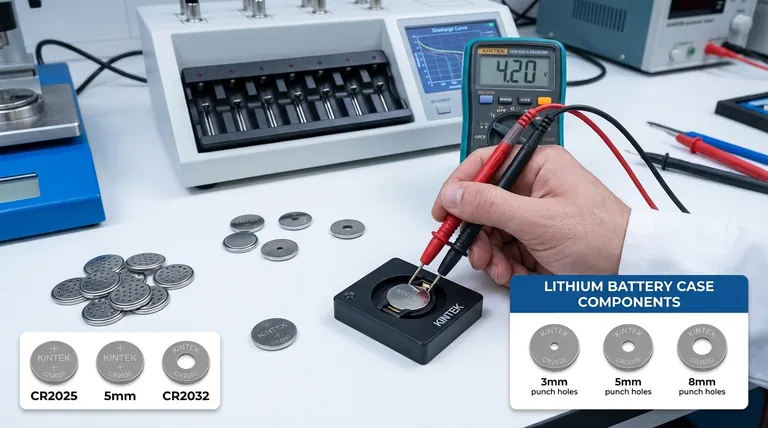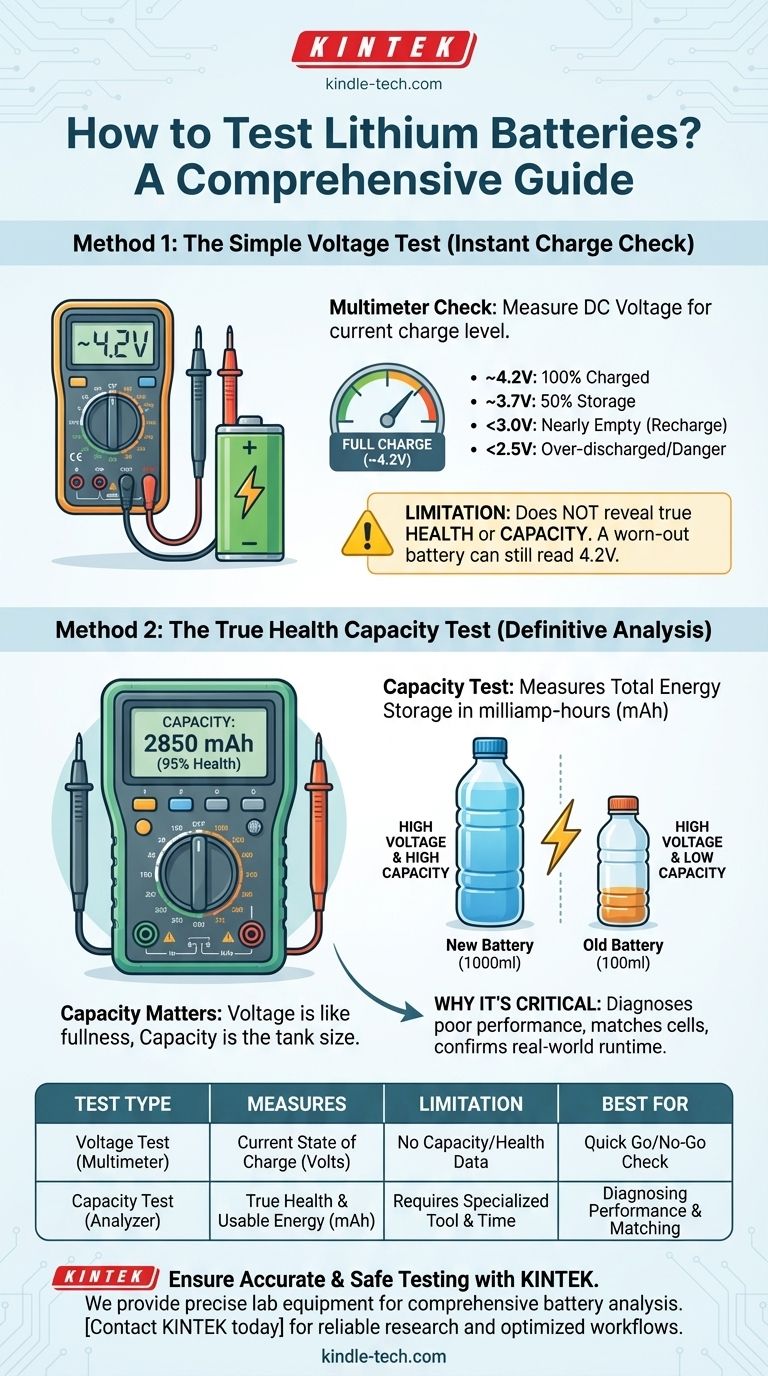Yes, you can test a lithium battery, and the most basic method involves using a multimeter to check its voltage. By connecting the multimeter's probes to the battery's terminals, you can get an instant reading of its current charge level. For a typical lithium-ion cell, a reading near 4.2 volts indicates it is fully charged.
While a multimeter is excellent for measuring a battery's current state of charge, it does not reveal the battery's true health or capacity. A battery can show a full voltage but have significantly degraded performance, making a simple voltage test potentially misleading for evaluating its overall condition.

The Simple Voltage Test: What It Actually Tells You
A voltage test is a quick diagnostic, like checking the fuel gauge in a car. It tells you how much energy is available right now, but it doesn't tell you the size of the fuel tank.
How to Use a Multimeter Safely
First, set your multimeter to the "DC Voltage" setting, choosing a range that is higher than the battery's maximum voltage (e.g., the 20V setting).
Connect the red probe to the battery's positive (+) terminal. Then, connect the black probe to the negative (-) terminal.
Interpreting the Voltage Reading
The voltage reading corresponds directly to the battery's current state of charge.
- ~4.2V: The battery is 100% charged.
- ~3.7V: This is the nominal, or "storage," voltage, roughly 50% charged.
- ~3.0V - 3.2V: The battery is nearly empty and should be recharged.
A reading significantly below 3.0V may indicate the battery has been over-discharged, which can cause permanent damage.
The Critical Limitation of a Voltage Test
An old, worn-out battery can still charge to 4.2V. However, it will lose that charge much faster under load than a new battery. The voltage reading alone gives you no information about this performance degradation.
Beyond Voltage: Testing True Battery Health (Capacity)
To understand if a battery is still "good," you must measure its capacity. This is the equivalent of measuring the actual size of the fuel tank, not just how full it is.
What is Battery Capacity?
Capacity is the total amount of energy a battery can store, typically measured in milliamp-hours (mAh). A new 3000 mAh battery can deliver more energy for a longer time than an old, degraded battery that now only holds 1500 mAh.
Why Capacity Matters More Than Voltage
Imagine two water bottles. One is a large 1-liter bottle, and the other is a tiny 100ml bottle. When both are filled to the top, they appear "full" (this is the voltage). But the 1-liter bottle can sustain you much longer (this is the capacity).
A high voltage reading on a low-capacity battery gives a false sense of security. The device may turn on, but it will die very quickly.
How to Perform a Capacity Test
A true capacity test requires a specialized tool, such as a smart battery charger with an analysis function or a dedicated battery analyzer.
The process involves a full charge/discharge cycle. The analyzer will fully charge the battery, then discharge it through a controlled load while precisely measuring how much energy it delivers until it's empty. This result is the battery's actual, usable capacity.
Understanding the Trade-offs
Choosing a testing method depends on what you need to know and the tools you have available.
The Multimeter Method: Quick but Incomplete
This is the ideal test for a quick check. It's fast, cheap, and requires only basic equipment. It answers the question, "Is this battery charged or dead right now?"
The Capacity Test: Definitive but Complex
This is the only way to get a definitive answer on a battery's health. It requires more time and specialized equipment, but it answers the crucial question, "How much life does this battery have left?"
Making the Right Choice for Your Goal
To determine the best approach, first identify your primary objective.
- If your primary focus is a quick go/no-go check: Use a multimeter to see if the battery has a charge.
- If your primary focus is to diagnose poor performance: A capacity test is necessary to confirm if the battery itself is the cause of the short runtime.
- If your primary focus is to match or sort used batteries: You must perform a capacity test to group cells with similar real-world performance.
- If a battery shows 0V or a voltage below 2.5V: It is likely permanently damaged and potentially unsafe; it should be responsibly recycled.
Understanding the difference between a battery's immediate charge and its long-term health is the key to accurately evaluating its true condition.
Summary Table:
| Test Type | What It Measures | Key Limitation | Best For |
|---|---|---|---|
| Voltage Test (Multimeter) | Current State of Charge (e.g., ~4.2V = Full) | Does not reveal degraded capacity or true health. | Quick go/no-go check to see if a battery is charged. |
| Capacity Test (Analyzer) | True Health & Usable Energy (mAh) | Requires specialized equipment and more time. | Diagnosing poor performance, matching used cells, definitive health check. |
Ensure Accurate and Safe Battery Testing in Your Lab
Accurate battery testing is critical for reliable research, product development, and quality control. While a multimeter provides a basic check, a true capacity test delivers the definitive data you need.
KINTEK specializes in lab equipment and consumables, serving laboratory needs. We provide the precise tools and support necessary for comprehensive battery analysis, helping you avoid the pitfalls of misleading voltage readings.
Let us help you achieve:
- Reliable Performance Data: Get accurate capacity measurements for your research and testing protocols.
- Enhanced Safety: Properly identify damaged or degraded batteries to maintain a safe lab environment.
- Optimized Workflows: Equip your lab with the right analyzers and chargers for efficient and repeatable results.
Contact KINTEK today to discuss your specific battery testing requirements and find the ideal solution for your laboratory.
Visual Guide

Related Products
- Li-Air Battery Case for Battery Lab Applications
- Button Battery Case for Battery Lab Applications
- Laboratory Test Sieves and Sieving Machines
- Filter Testing Machine FPV for Dispersion Properties of Polymers and Pigments
- Benchtop Laboratory Vacuum Freeze Dryer
People Also Ask
- How to check the power of a lithium-ion battery? Master the difference between charge level and battery health.
- How should the PTFE electrode stand and its components be cleaned after use? A Step-by-Step Guide to Prevent Contamination
- What are the operational steps to follow during an electrochemical experiment? A Guide to Accurate, Reproducible Results
- How should electrodes be maintained? A Guide to Ensuring Accurate Measurements and Longevity
- How should the electrolyte be managed as part of maintenance? A Proactive Guide to System Longevity



















